1995 CADILLAC SEVILLE check engine
[x] Cancel search: check enginePage 43 of 410
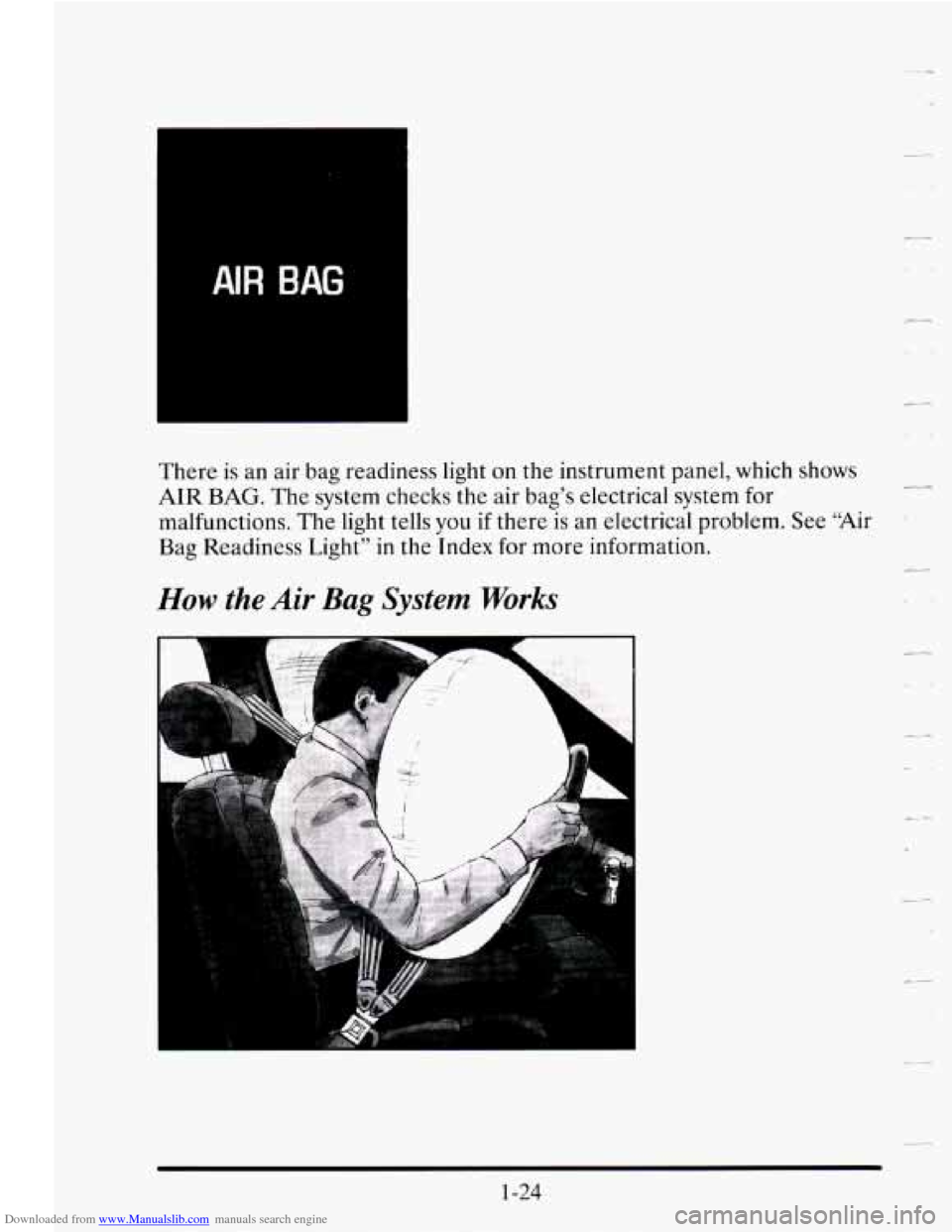
Downloaded from www.Manualslib.com manuals search engine AIR BAG
There is an air bag readiness light on the instrument panel, which shows
AIR BAG. The system checks the air bag’s electrical system for
malfunctions. The light tells
you if there is an electrical problem. See “Air
Bag Readiness Light” in the Index for more information.
-
How the Air Bag System Works
1-24
Page 70 of 410
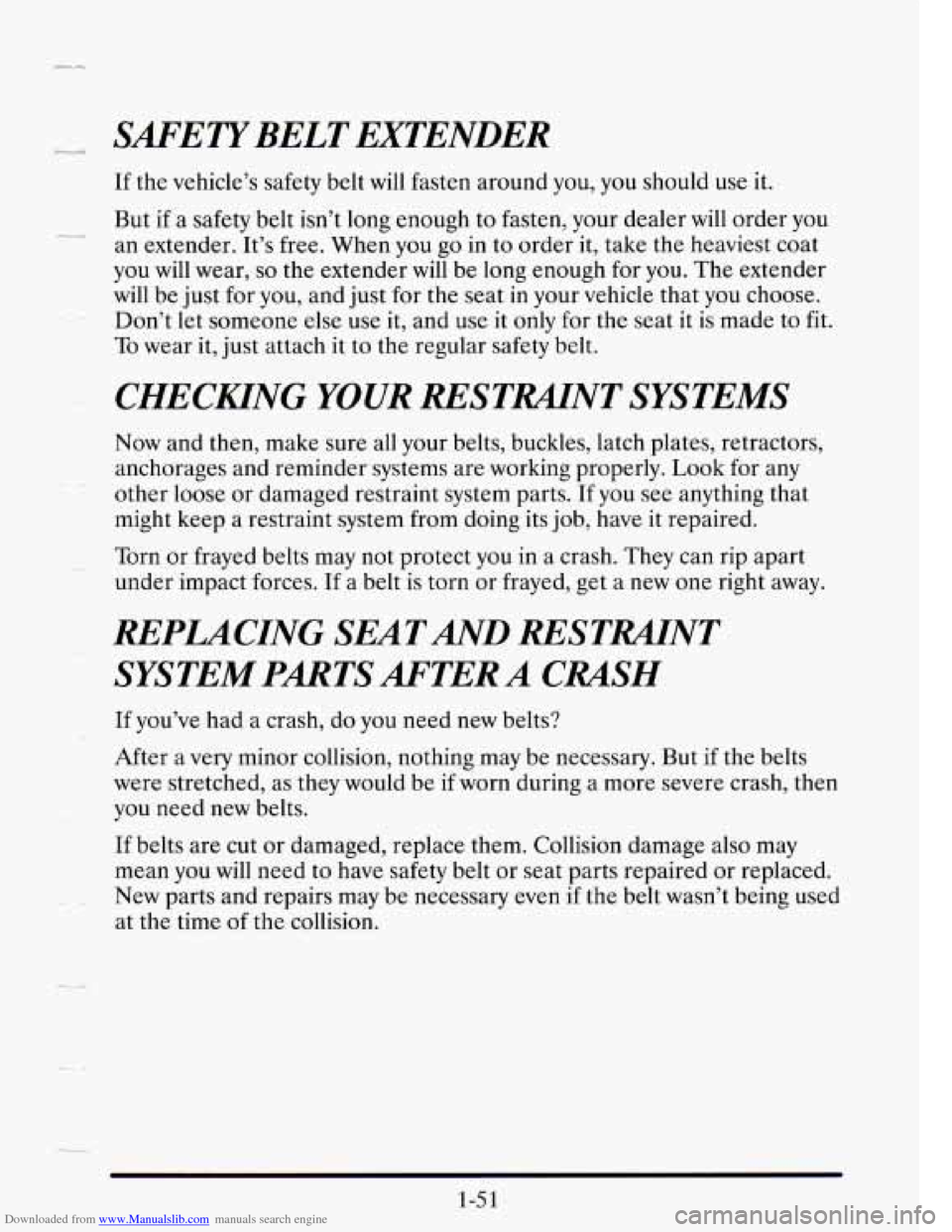
Downloaded from www.Manualslib.com manuals search engine SAFETYBELT EXTENDER
If the vehicle’s safety belt will fasten around you, you should use it.
But if a safety belt isn’t long enough to fasten, your dealer
will order you
an extender. It’s free. When you go
in to order it, take the heaviest coat
you will wear,
so the extender will be long enough for you. The extender
will be just for you, and just for the seat in your vehicle that you choose.
Don’t let someone else use it, and use it only for the seat it is made to fit.
To wear it, just attach it to the regular safety belt.
--
CHECKING YOUR RESTUNT SYSTEMS
Now and then, make sure all your belts, buckles, latch plates, retractors,
anchorages and reminder systems are working properly. Look for any
other loose or damaged restraint system parts. If you see anything that
might keep a restraint system from doing its job, have it repaired.
Torn or frayed belts may not protect you
in a crash. They can rip apart
under impact forces. If a belt is torn or frayed, get a new one right away.
REPLACING SEATAND RESTMNT
SYSTEM PARTS AFTER A CRASH
If you’ve had a crash, do you need new belts?
After a very minor collision, nothing may be necessary. But if the belts
were stretched,
as they would be if worn during a more severe crash, then
you need new belts.
If belts are cut or damaged, replace them. Collision damage also may
mean you will need to have safety belt or seat parts repaired or replaced.
New parts and repairs may be necessary even
if the belt wasn’t being used
at the time
of the collision.
1-5 1
Page 79 of 410
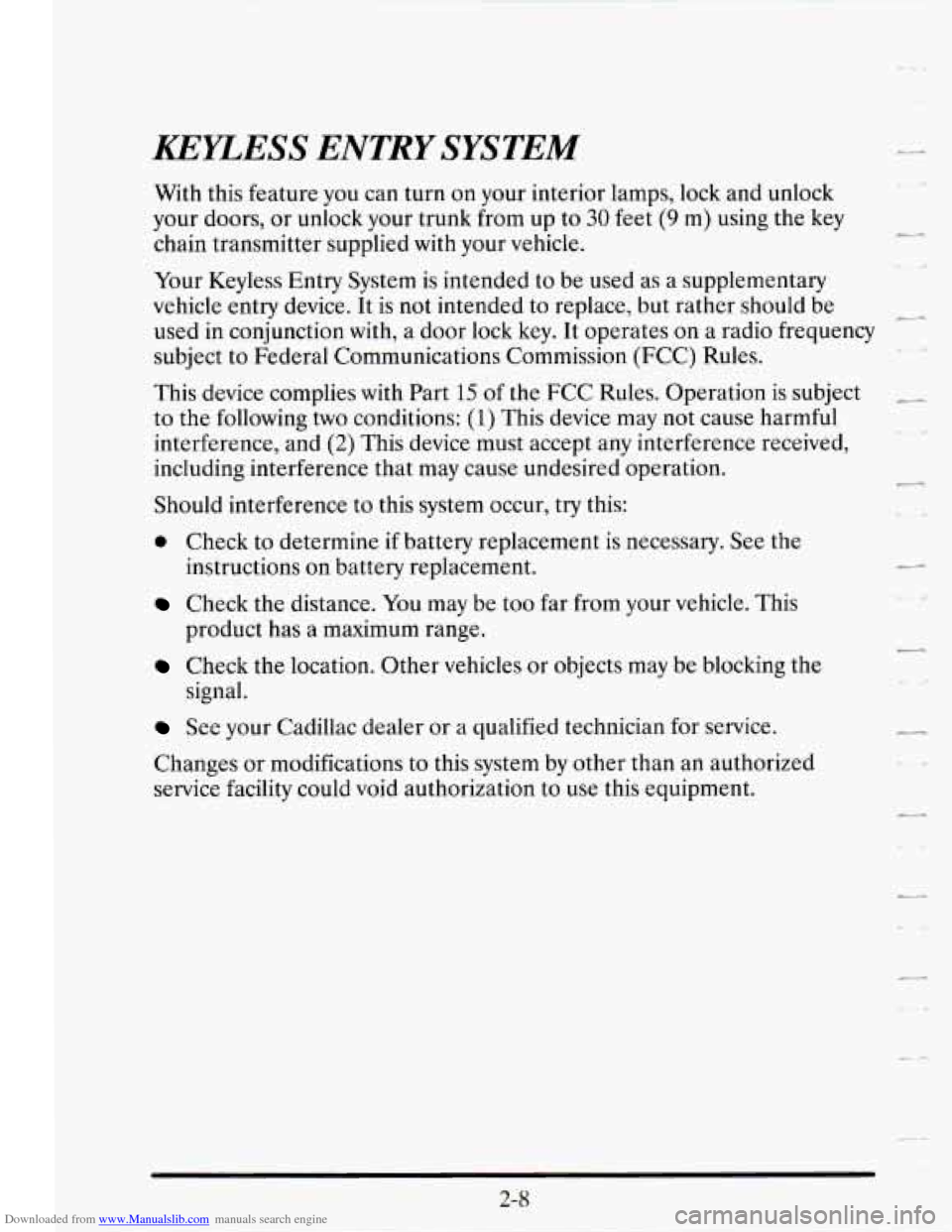
Downloaded from www.Manualslib.com manuals search engine KEYLESS ENTRY SYSTEM
With this feature you can turn on your interior lamps, lock and unlock
your doors, or unlock your trunk from up to
30 feet (9 m) using the key
chain transmitter supplied with your vehicle.
Your Keyless Entry System is intended to be used as a supplementary
vehicle entry device. It is not intended to replace, but rather should be
used in conjunction with, a door lock
key. It operates on a radio frequency
subject to Federal Communications Commission (FCC) Rules.
This device complies with Part
15 of the FCC Rules. Operation is subject
to the following
two conditions: (1) This device may not cause harmful
interference, and
(2) This device must accept any interference received,
including interference that may cause undesired operation.
Should interference
to this system occur, try this:
0 Check to determine if battery replacement is necessary. See the
Check the distance. You may be too far from your vehicle. This
Check the location. Other vehicles or objects may be blocking the
See your Cadillac dealer or a qualified technician for service.
instructions
on battery replacement.
product has a maximum range.
signal.
Changes or modifications to this system by other than an authorized
service facility could void authorization to
use this equipment.
2-8
Page 88 of 410
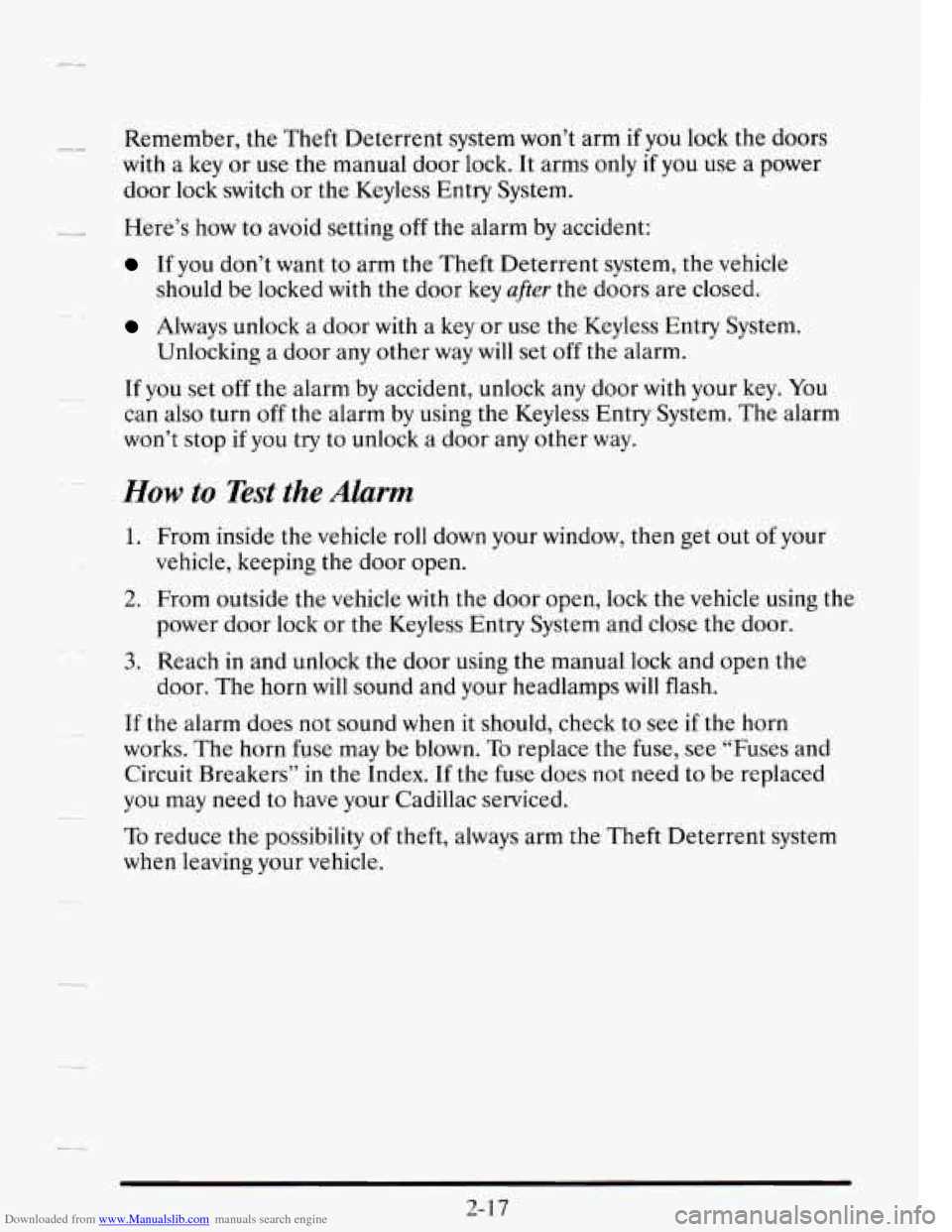
Downloaded from www.Manualslib.com manuals search engine _L Remember, the Theft Deterrent system won’t arm if you lock the doors
with a key or use the manual door lock. It arms only
if you use a power
door lock switch or the Keyless Entry System.
__ Here’s how to avoid setting off the alarm by accident:
c-
If you don’t want to arm the Theft Deterrent system, the vehicle
should be locked with the door
key after the doors are closed.
Always unlock a door with a key or use the Keyless Entry System.
Unlocking a door any other way will set
off the alarm.
If you set off
the alarm by accident, unlock any door with your key. You
can also turn off the alarm by using the Keyless Entry System. The alarm
won’t stop if you try to unlock a door any other way.
How to Test the Alarm
1. From inside the vehicle roll down your window, then get out of your
2. From outside the vehicle with the door open, lock the vehicle using the
vehicle, keeping
the door open.
power door lock or the Keyless Entry System and close the door.
3. Reach in and unlock the door using the manual lock and open the
door. The horn
will sound and your headlamps will flash.
If the alarm does not sound when it should, check to see if the horn
works. The horn fuse may be blown.
To replace the fuse, see “Fuses and
Circuit Breakers” in the Index. If the fuse does not need to be replaced
you may need to have your Cadillac serviced.
To reduce the possibility
of theft, always arm the Theft Deterrent system
when leaving your vehicle.
2-17
Page 89 of 410

Downloaded from www.Manualslib.com manuals search engine PASSmKEY’II
Your vehicle is equipped with the PASS-Key@II (Personalized Automotive
Security System) theft deterrent system. PASS-Key@II is a passive theft
deterrent system. This means
you don’t have to do anything different to
arm or disarm the system. It works when you insert or remove the key
from the ignition. PASS-Key’II uses
a resistor pellet in the ignition key
that matches
a decoder in your vehicle.
When the PASS-Key% system senses that someone is using the wrong
key, it shuts down the vehicle’s starter and fuel systems. For about three
minutes, the starter won’t work and fuel won’t
go to the engine. If
someone tries to start your vehicle again or uses another key during this
time, the vehicle will not start. This discourages someone from randomly
trying different keys with different resistor pellets in an attempt to make a
I--
match.
The ignition key must be clean and
dry before it’s inserted in the ignition
or the engine may not start.
If the engine does not start and the
SECURITY light comes on, the key may be dirty or wet. Turn the
ignition
off.
--
Clean and dry the key. Wait about three minutes and try again. The
security light may remain
on during this time. If the starter still won’t
work, and the key appears to be clean and dry, wait about three minutes
and try another ignition key. At this time, you may also want to check the
-
fuses (see “Fuses and Circuit Breakers” in the Index). If the starter won’t
work with the other key, your vehicle needs service. If your vehicle does
start, the first ignition key may be faulty. See your Cadillac dealer or a
locksmith who can service the PASS-Key@II. .I
If you accidentally use a key that has a damaged or missing resistor pellet,
the starter won’t
work and the SECURITY light will flash. But you don’t
have to wait three minutes before trying another ignition key. -
See your Cadillac dealer or a locksmith who can service the PASS-Key%
to have a new key made.
-
3- 18
Page 93 of 410
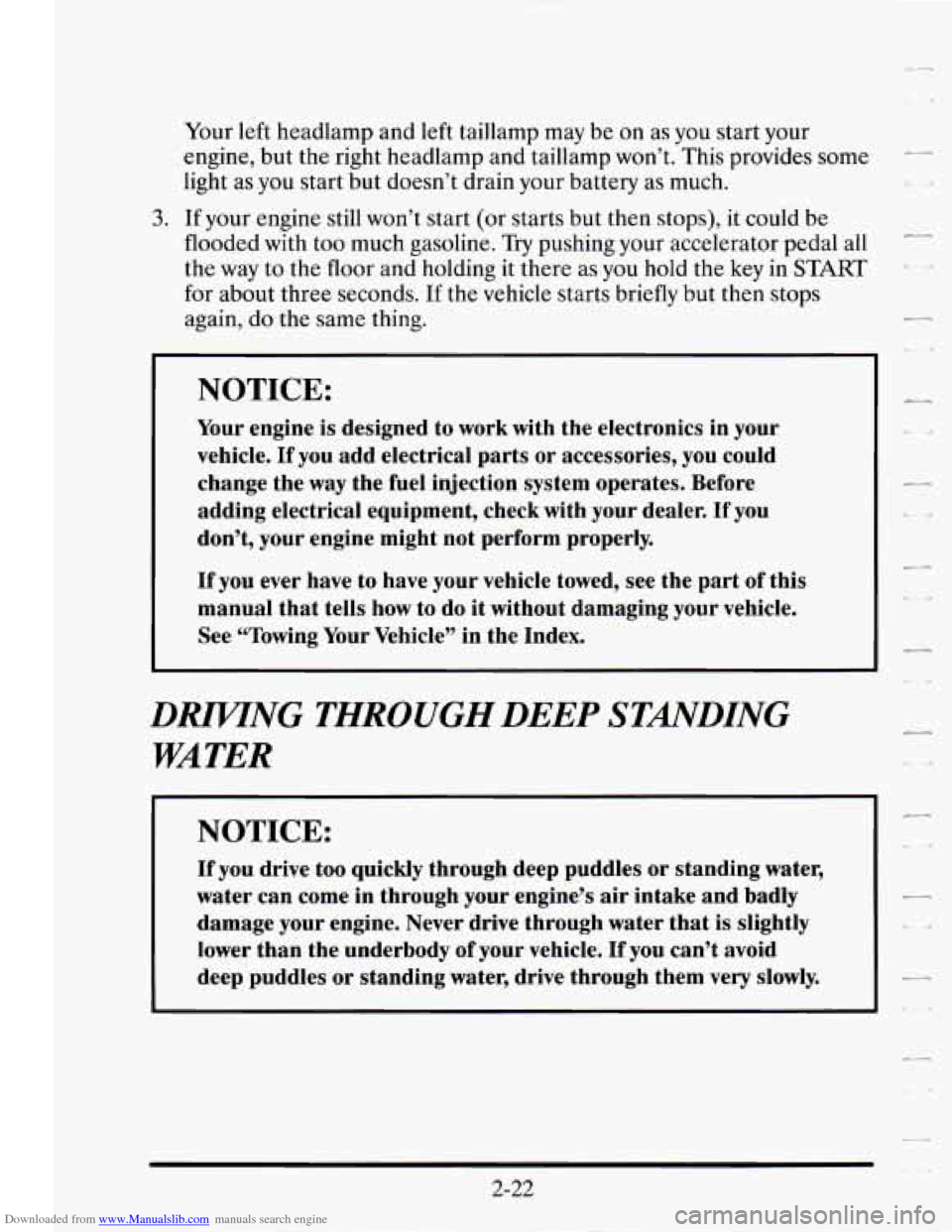
Downloaded from www.Manualslib.com manuals search engine Your left headlamp and left taillamp may be on as you start your
engine, but the right headlamp and taillamp won’t. This provides some
light as
you start but doesn’t drain your battery as much.
3. If your engine still won’t start (or starts but then stops), it could be
flooded with too much gasoline.
Try pushing your accelerator pedal all
the way to the floor and holding it there as
you hold the key in START
for about three seconds. If the vehicle starts briefly but then stops
again, do the same thing.
NOTICE:
Your engine is designed to work with the electronics in your
vehicle. If you add electrical parts or accessories, you could
change the way the fuel injection system operates. Before
adding electrical equipment, check with your dealer.
If you
don’t, your engine might not perform properly.
If you ever have to have your vehicle towed, see the part of this
manual that tells how to do it without damaging your vehicle.
See “Towing Your Vehicle” in the Index.
DMNG THROUGHDEEP STANDING
WATER
NOTICE:
If you drive too quickly through deep puddles or standing water,
water can come in through your engine’s air intake and badly
damage your engine. Never drive through water that is slightly
lower than the underbody
of your vehicle. If you can’t avoid
deep puddles
or standing water, drive through them very slowly.
c_
.I
2-22
Page 113 of 410
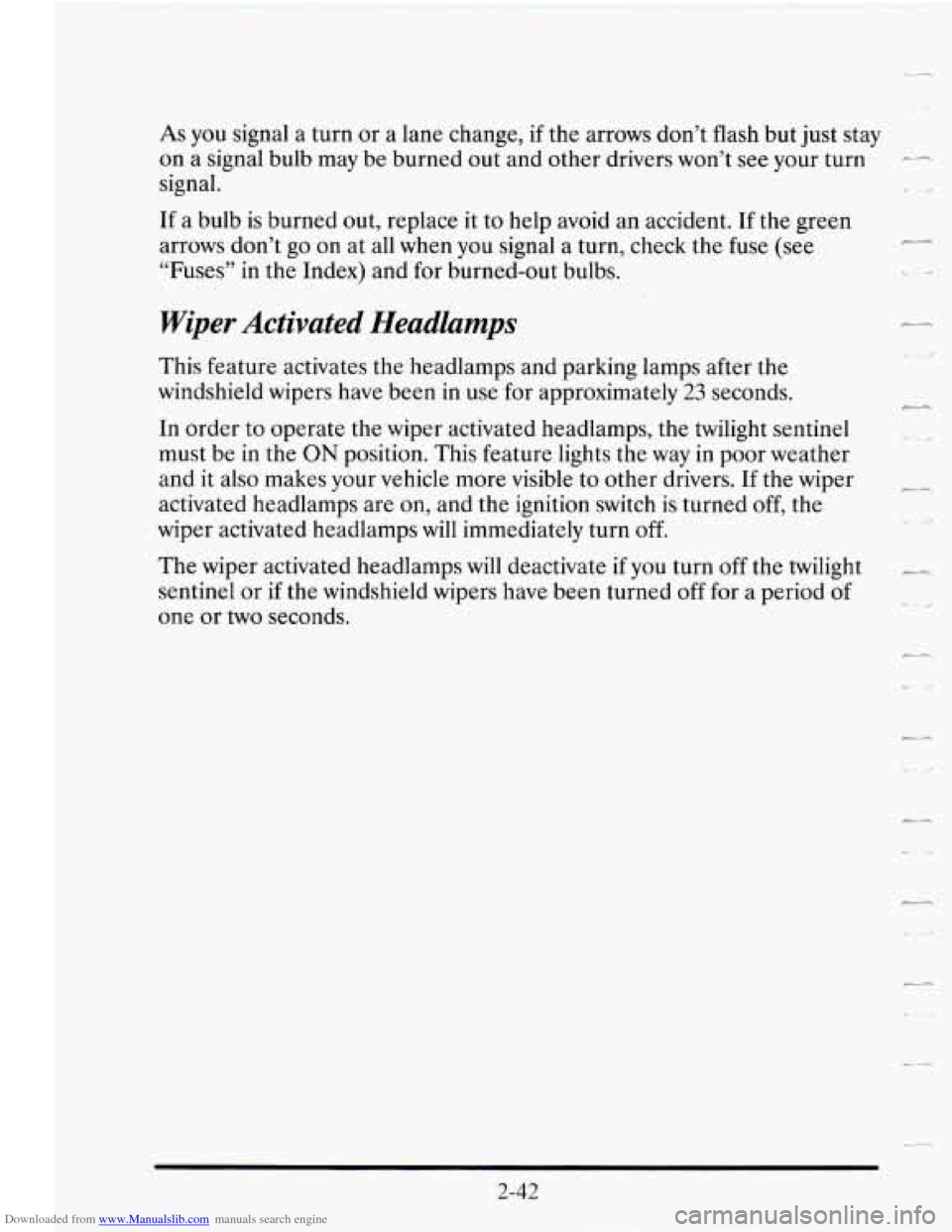
Downloaded from www.Manualslib.com manuals search engine As you signal a turn or a lane change, if the arrows don’t flash but just stay
on a signal bulb may be burned out and other drivers won’t see your turn
--
signal.
If
a bulb is burned out, replace it to help avoid an accident. If the green
arrows don’t go on at all when you signal
a turn, check the fuse (see
“Fuses’’ in the Index) and for burned-out bulbs.
Wiper Activated Headlamps
This feature activates the headlamps and parking lamps after the
windshield wipers have been in use
for approximately 23 seconds.
In order to operate the wiper activated headlamps, the twilight sentinel
must be in the
ON position. This feature lights the way in poor weather
and
it also makes your vehicle more visible to other drivers. If the wiper
activated headlamps are on, and the ignition switch is turned off, the
wiper activated headlamps
will immediately turn off.
The wiper activated headlamps will deactivate
if you turn off the twilight -
sentinel or if the windshield wipers have been turned off for a period of
one or two seconds.
2-42
Page 116 of 410
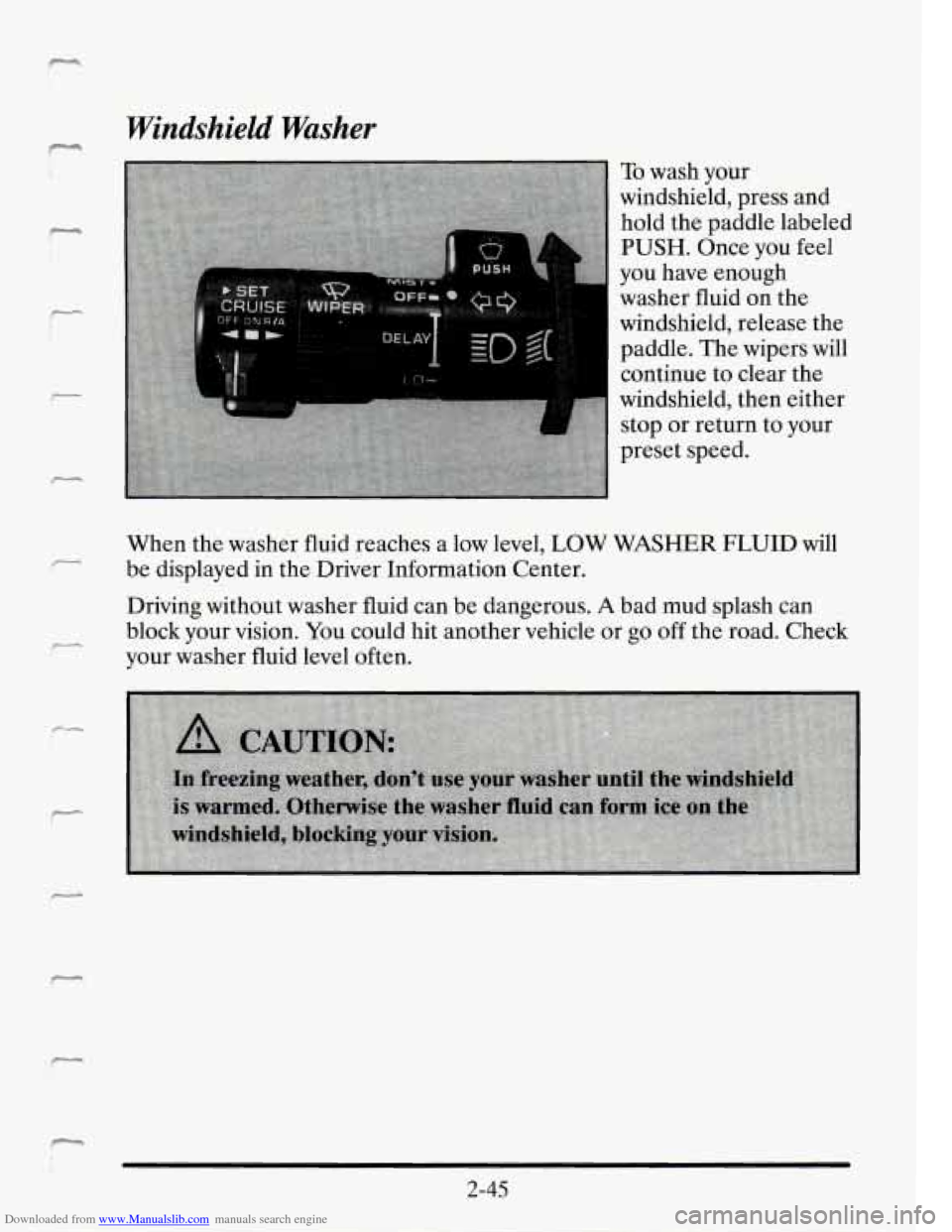
Downloaded from www.Manualslib.com manuals search engine F 4
7
Windshield Washer
To wash your
windshield, press and
hold the paddle labeled
PUSH. Once you feel
you have enough
washer fluid on the
windshield, release the
paddle. The wipers will
continue to clear the
windshield, then either
stop or return to your
preset speed.
When the washer fluid reaches a low level,
LOW WASHER FLUID will
be displayed in the Driver Information Center.
Driving without washer fluid can be dangerous.
A bad mud splash can
block your vision.
You could hit another vehicle or go off the road. Check
your washer fluid level often.
2-45